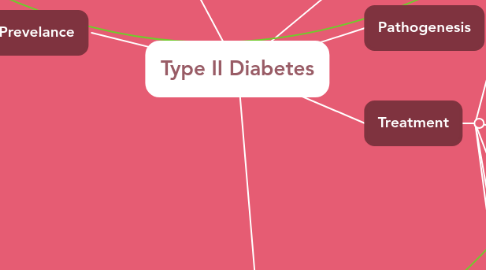
1. Incidence/Prevelance
1.1. Accounts for 90-95% of cases
1.2. Affects 9.3% of adults in the U.S.
1.3. Prevalence is highest among American Indians and Alaska natives
1.4. Prevalence lowest among non-Hispanic whites
1.5. Increase prevalence in obese children
1.6. Risk increases after age 40
1.7. In up to 10% of pregnancies, mother diagnosed
1.8. 400 million people living with diabetes in 2015
1.9. New node
2. Diagnostics
2.1. Glycated hemoglobin (A1C) test
2.1.1. Average blood sugar for the past 2-3 months
2.1.1.1. Measures amount of blood sugar attached to hemoglobin
2.1.1.1.1. 6.6% or greater= diabetes
2.1.1.1.2. 5.7-6.4%= prediabetes
2.1.1.1.3. Below 5.7%= normal
2.2. Random blood sugar test
2.2.1. 200 mg/dL or higher=diabetes
2.3. Fasting blood sugar
2.3.1. Taken after an overnight fast
2.3.1.1. 100-125 mg/dL= prediabetes
2.3.1.2. 126 mg/dL or higher on two separate test=diabetes
2.4. Oral glucose tolerance test
2.4.1. Fast overnight, measurement is taken, then drink 2 sugary drinks and blood sugar is tested periodically for 2 hours
2.4.1.1. Less than 140 mg/dL=normal
2.4.1.2. 140-199 mg/dL=prediabetes
2.4.1.3. 200 mg/dL or higher after 2 hours=diabetes
3. Clinical Manifestations (S/S)
3.1. Overweight
3.2. Dyslipidemic
3.3. Hyperinsulinemia
3.4. Hypertension
3.5. Fatigue
3.6. Pruritus
3.7. Recurrent Infections
3.8. Visual changes
3.9. Neuropathy
3.9.1. Parathesis
3.9.2. Weakness
3.10. Progressed without treatment
3.10.1. Have symptoms R/T
3.10.1.1. Coronary artery disease
3.10.1.2. Peripheral artery disease
3.10.1.3. Cerebrovascular disease
4. References: Nijpels, G. (2016, November 23). Epidemiology of type 2 diabetes. Retrieved November 02, 2017. Santos-Longhurst, A. (2017, February 27). Type 2 Diabetes Statistics yand Facts. Retrieved November 02, 2017 Type 2 diabetes. (2017, October 06). Retrieved November 02, 2017
5. Pathogenesis
5.1. Insulin resistance
5.1.1. Abnormality of insulin molecule
5.1.2. High amounts of insulin antagonists
5.1.3. Down-regulation of insulin receptor
5.1.4. Alteration of glucose transporter (GLUT) proteins
5.2. Beta-cell mass and function
5.2.1. Deficiency of insulin activity
5.2.1.1. Decrease in beta-cell mass
5.2.1.2. Reduction in normal beta-cell function
5.3. Obesity
5.3.1. Adipokines produced in adipose tissue
5.3.1.1. Inflammation and decreased insulin sensitivity
5.3.2. Elevated levels of serum free fatty acids (FFAs), triglycerides and cholesterol
5.3.2.1. Interfere with intracellular insulin signaling
5.3.2.2. Decrease tissue responses to insulin
5.3.2.3. Alter incretin actions and promote inflammation
5.3.3. Inflammatory cytokines released
5.3.3.1. Induce insulin resistance
5.3.3.2. Cytotoxic to beta cells
5.3.4. Hyperinsulinemia and decreased receptor density
5.4. Increase glucagon concentration
5.4.1. Pancreatic alpha cells become less responsive to glucose inhibition
5.4.1.1. Increase in glucagon secretion
5.5. Amylin decrease
5.5.1. Islet cell destruction
5.5.1.1. Depositing of abnormal (misfolded) amyloid polypeptide in pancreas
5.6. Decrease ghrelin
5.6.1. Insulin resistance
5.6.2. Increased fasting insulin levels
6. Treatment
6.1. Prevention
6.1.1. Diet
6.1.1.1. More complex carbohydrates (rather than simple sugars)
6.1.1.2. Foods low in fat
6.1.1.3. Adequate protein
6.1.1.4. Fiber
6.1.2. Exercise
6.1.2.1. Weight loss
6.1.2.1.1. Results in improved glucose tolerance
6.2. Restoration of normal blood glucose level
6.3. Bariatric surgery
6.3.1. Improves glycemic control
6.3.2. Decreases risk of cardiovascular disease
6.3.3. Promotes weight loss for those morbidly obese
6.4. Medication
6.4.1. Oral hypoglycemic agents
6.4.1.1. GLP-1 receptor agonist
6.4.1.1.1. Promotes glucose-dependent insulin secretion
6.4.1.1.2. Reduces beta-cell apoptosis
6.5. Insulin therapy
6.5.1. Insulin injection
